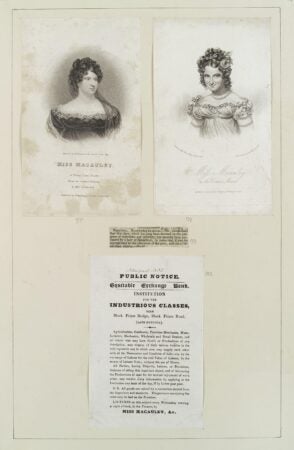Guidance for special collections preservation: Using JSTOR Digital Stewardship Services to support your long-term goals

Page of Ephemera from the Surrey Rotunda, c. 1832. n.d. Wellcome Collection.
What is digital preservation and why is it important?
Digital preservation is the active management of digital content over time to ensure it remains accessible, usable, and meaningful for future generations. In an age where scholarship, cultural heritage, and historical records are increasingly born-digital, the risk of loss due to technological obsolescence, corruption, or human error has never been greater.
Without deliberate preservation strategies, we risk losing vital artifacts of human knowledge and culture. Digital stewardship ensures that today’s knowledge will be available tomorrow, protecting against degradation, accidental deletion, and the eventual obsolescence of file formats and storage media. It is a commitment to future scholarship, to cultural continuity, and to the shared record of human achievement.
How JSTOR Digital Stewardship supports your preservation goals
Preserving institutional special collections and archives is a vital task—one that requires not only reliable storage but also intentional, strategic stewardship. JSTOR Digital Stewardship Services offers a powerful, resilient platform designed to help institutions safeguard their digital assets and ensure their collections remain accessible, authentic, and usable for generations to come.
Digital content is vulnerable to threats ranging from bit rot and accidental deletion to technological obsolescence. Without a plan in place, even carefully curated collections can be lost over time. By leveraging JSTOR’s trusted infrastructure and thoughtful best practices, institutions can actively protect their cultural and scholarly heritage.
To ensure you’re maximizing the value of your allocated storage space and setting up your collections for long-term success, we recommend the following actions:
Prioritize high-value content: Focus on preserving rare, unique, mission-critical, and historically significant materials first. Document the rationale behind your preservation decisions to maintain a clear archival strategy.
Optimize file formats for longevity: Choosing the right file format is essential to ensuring content can be accessed in the future. Prioritize preserving files in open, sustainable formats such as TIFF, PDF/A, XML, and CSV. These formats are widely supported and less prone to obsolescence than proprietary alternatives. For guidance on evaluating file formats for long-term preservation, we recommend reviewing the Library of Congress Sustainability Factors, which provide detailed insights into format suitability.
Prepare files before uploading: Before uploading, take time to ensure your content is well-organized and clearly contextualized. While JSTOR Digital Stewardship will perform integrity checks to identify file corruption, it’s still helpful to confirm that files are complete and appropriately structured. If your content includes supplementary materials (e.g., transcripts, indexes, or contextual documents), group and label them logically to maintain clarity and meaning across your collection. Thoughtful preparation improves user experience and supports long-term usability. Good preparation reduces errors and enhances the usability of your digital archive.

National Library of Medicine. Going… Going… Gone. You Can Help Preserve Our Medical Heritage.
Leverage metadata for discoverability: Just as rich, standardized metadata enhances the discoverability of your shared collection, it also adds long-term value to the preservation of files. Include key details like creator, date, rights, and context, using standards like Dublin Core or MODS wherever possible. It’s easier to modify or delete metadata in the future than try to “add it back” after the fact.
Manage storage intentionally: While JSTOR Digital Stewardship provides generous storage, it is not unlimited. Be strategic about how you allocate space by carefully reviewing files before uploading and evaluating the level of quality necessary to meet your preservation goals.
Because preservation versioning retains every iteration of submitted content, it’s best to begin preserving only once both the content and metadata are relatively stable. Submitting updates—even small ones—can result in additional versions being stored, which can impact your storage allocation over time. Be strategic about how you allocate space by carefully reviewing files before uploading and evaluating the level of quality necessary to meet your preservation goals. For example, capturing content at the highest resolution may not always be practical or needed, especially when it results in significantly larger file sizes. Consider whether multiple formats or versions of the same material are truly required, and prioritize storing the most purposeful representations. Smart storage management ensures your space is used to preserve the most impactful materials while balancing long-term sustainability.
Be thoughtful with versions: Preservation with JSTOR Digital Stewardship saves every uploaded version as a separate instance, rather than overwriting older files. To avoid unnecessary storage use, finalize files before uploading and use clear, versioned filenames (e.g., CollectionGuide_v2_2025-04-25.pdf).
Audit and review regularly: Digital preservation is not a “set it and forget it” task. Use the Audit site to review your content and confirm that it appears as expected. While the Stewardship Service performs fixity checks to monitor file integrity, it’s still valuable to visually confirm that your content is complete and properly represented. Annual check-ins are a helpful way to maintain clarity, confirm collection accuracy, and inform future planning.
Benefit from built-in redundancy: Your materials are automatically replicated across multiple repositories, providing strong protection against data loss and ensuring content availability even in the event of a system failure. While JSTOR Digital Stewardship provides this level of durability by design, it can still be beneficial to maintain an institutional copy of mission-critical materials. As the field of digital preservation evolves, there’s increasing awareness of the environmental and management costs associated with excessive duplication.
We encourage thoughtful redundancy—balancing resilience with sustainability—as part of a responsible digital preservation strategy. For more on this evolving perspective, see the Digital Preservation Coalition’s reflection on good vs. best practice.
Quick tips for success
- Upload finalized versions only to minimize unnecessary duplication.
- Use preservation-friendly formats to future-proof your collections.
- Monitor your storage usage to maximize your allocation.
- Add detailed metadata to enhance searchability and context.
- Review your archive annually to keep it relevant and organized.
By following these best practices, you can ensure your institution’s special collections are preserved with care, intention, and maximum benefit.
Learn more about JSTOR Digital Stewardship Services, and join us in advancing responsible, mission-driven digital preservation.
Related reading
About the author

Lee Dotson is the Senior Digital Collections Success Manager at ITHAKA with over 25 years of experience in academic libraries. She brings deep expertise in digital initiatives, from building impactful collections to leading large-scale digitization projects and collaborative repository efforts. She is a graduate of the Sunshine State Library Leadership Institute, a participant in the Digital POWRR peer assessment program, and an enthusiastic mentor for early career librarians and repository managers. Passionate about innovation and access, Lee is excited to support JSTOR Digital Stewardship Services and build meaningful, lasting partnerships across the scholarly community.